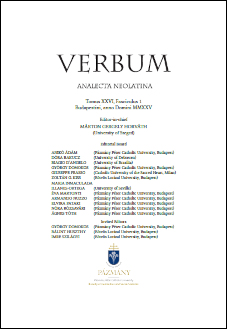Per i 70 anni di Giampaolo Salvi
Published 10-07-2025
Keywords
- syntax,
- passive,
- modal,
- deontic,
- motion verbs
How to Cite
Cinque, G. (2025). Andare ausiliare del passivo deontico. Verbum – Analecta Neolatina, 26(1), 73–82. https://doi.org/10.59533/Verb.2025.26.1.4

This work is licensed under a Creative Commons Attribution 4.0 International License.
Abstract
The Italian auxiliary andare ‘go’ is ambiguous between a purely passive usage and a modal (deontic) passive one. The two uses differ with respect to a number of properties, which are examined here. The pure passive usage is more constrained than the modal (deontic) usage as it is possible with only few verbs (of ‘loss’ and ‘disappearance’), and unlike the ordinary passive construction does not admit an agentive phrase. In this article particular attention is dedicated to the second, modal (‘deontic’) passive, usage.
References
- Bertinetto, P. M. (199) Il verbo. In L. Renzi & G. Salvi, eds., Grande grammatica italiana di consultazione, Vol. 2. 13–161. Bologna: Il Mulino.
- Bourdin, P. (2014) When come and go go necessive. In M. Devos & J. van der Wal, eds., COME and GO off the Beaten Grammaticalization Path. 103–164. Berlin: de Gruyter.
- Cinque, G. (1999) Adverbs and Functional Heads. A Cross-Linguistic Perspective. New York: Oxford University Press. https://www.academia.edu/58433772/Adverbs_and_Functional_Heads
- Cinque, G. (2003) The Interaction of Passive, Causative, and Restructuring in Romance. In C. Tortora, ed., The Syntax of Italian Dialects. 50–66. New York: Oxford University Press. https://www.academia.edu/58613374/Interaction_of_Passive_Causative_and_Restructuring_in_Romance
- Cinque, G. (2023) On Linearization. Toward a Restrictive Theory. Cambridge, Mass.: MIT Press. https://direct.mit.edu/books/oa-monograph/5553/On-LinearizationToward-a-Restrictive-Theory
- Ernout, A. & F. Thomas. 1964. Syntaxe Latine. Paris: Librairie C. Klincksieck.
- Giacalone Ramat, A. 2000. On some grammaticalization patterns for auxiliaries. In J. C. Smith & D. Bentley, eds., Historical Linguistics 1995. Vol. I: General issues and non-Germanic languages. 279–300. Amsterdam: Benjamins.
- Grochowska-Reiter, A. (2020) Ausiliari del passivo nella didattica dell’italiano LS. Studia Romanica Posnaniensia 47/2: 33–46. https://www.academia.edu/44091555/Ausiliari_del_passivo_nella_didattica_dellitaliano
- Herczeg, G. 1966. La locuzione perifrastica andare + participio passato. Lingua Nostra XXVII: 58–64.
- Ishizuka, T. & H. Koopman (2014) On the importance of being silent or pronounced; English -able and Japanese -are potentials compared. Glow poster. https://linguistics.ucla.edu/wp-content/uploads/2017/04/On-the-importance-of-being-silent-or-pronounced.-English-able-and-Japanese-rare-potentials-compared.pdf
- Ishizuka, T. & H. Koopman (2023) On the similarities and differences between Japanese -rare potentials and passives. Ms., UCLA.
- Krapova, I. & G. Cinque. 2008. On the order of wh-phrases in Bulgarian multiple wh-fronting. In G. Zybatow, L. Szucsich, U. Junghanns & R. Meyer, eds., Formal Description of Slavic Languages: The Fifth Conference, Leipzig 2003. 318–336. Frankfurt am Main: Peter Lang. https://citeseerx.ist.psu.edu/viewdoc/download?doi=10.1.1.528.4215&rep=rep1&type=pdf
- Leone, A. (1966) Ancora su “andare + participio passato”. Lingua Nostra XVII: 117–121
- Lepschy, A. L. & G. Lepschy (1988) The Italian Language Today. London: Hutchinson.
- Lo Cascio, V. (1968) Struttura, funzione, valore di andare + participio passato. Lingua e stile 3: 271–293
- Mocciaro, E. (2014) Passive in motion: the Early Italian auxiliary andare (‘to go’). In M. Devos & J. van der Wal, eds., COME and GO off the Beaten Grammaticalization Path. 45–68. Berlin: de Gruyter.
- Peruzzi, E. (1958) Problemi di grammatica italiana. Torino: ERI.
- Rizzi, L. (2018) Intervention effects in grammar and language acquisition. Probus 30 (2): 339–367
- Salvi, G. (1980) Gli ausiliari “essere” e “avere” in italiano. Acta Linguistica Academiae Scientiarum Hungaricae 30: 137–162
- Salvi, G. (1988) La frase semplice. In L.Renzi (a cura di) Grande grammatica italiana di consultazione. Vol.1. 29–113. Bologna: Il Mulino.
- Sansò A. & A. Giacalone Ramat (2016) Deictic Motion Verbs as Passive Auxiliaries: The Case of Italian Andare ‘Go’ (and Venire ‘Come’). Transactions of the Philological Society 114: 1–24. https://onlinelibrary.wiley.com/doi/epdf/10.1111/1467-968X.12059
- Squartini, M. (1999) Voice clashing with aspect: The case of Italian Passives. Rivista di Linguistica 11(2): 341–365. https://www.italian-journal-linguistics.com/app/uploads/2021/06/5_Squartini.pdf
- Van Molle-Marechal, P. (1974) “Andare” e “venire” ausiliari del passivo. In M. Medici & A. Sangregorio (a cura di) Fenomeni morfologici e sintattici nell’italiano contemporaneo. Volume primo. Tomo secondo. 357–372. Roma: Bulzoni.

